14 October 2023
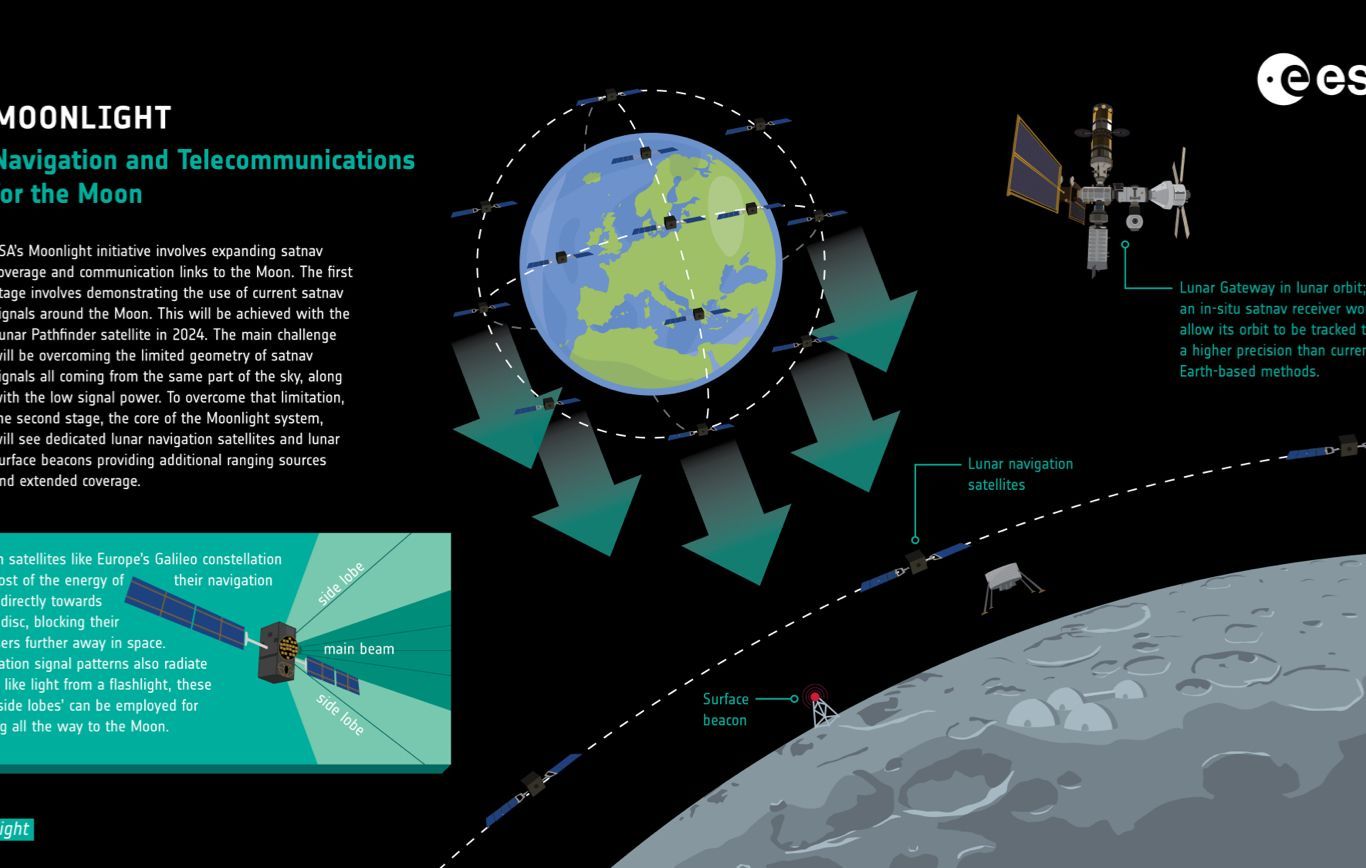
ESA Moonlight (Image: ESA-K Oldenburg)
A report by NASA’s Office of the Inspector General this week highlighted that it will be “unrealistic” for the agency to drastically reduce the spiralling cost of developing the giant SLS rocket used for the Artemis missions, casting doubt on the “…sustainability of NASA’s deep space human exploration efforts,” the report warned.
As we’ve previously mentioned, the Artemis programme could indeed be the last of its kind, of grand, publicly funding space projects. What we are now seeing is role of the private sector expanding, increasing efficiency and the pace of innovation, reducing costs and opening up access to space. With SpaceX’s Starship close to coming online, it’s hard to see if there will be a long-term future for the SLS rocket.
This really is a reflection of the industry as a whole right now, adapting and changing in the face of growing competition as nations realise the massive potential the future of space has to offer. This is moreover being spearheaded by private companies. In the US, NASA have established their Commercial Lunar Payload Services (CLPS) program, designed to purchase lunar landing services from private sector. Intuitive Machines will be the next company aiming to land on the Moon under the CLPS program, launching next month with SpaceX.
In 2020, India established the Indian National Space Promotion and Authorization Center (IN-SPACe), designed to act as a window for private companies entering the space sector. The growing space nation has now witnessed the first flights from private launch companies, and the government has recently carried out a series of reforms aimed at increasing private sector involvement.
The UK is also a rapidly growing space nation, with the bold aim of capturing 10% of the global market by 2030. The country has also now become the second most attractive place for space space venture capital investment, the US being the first.
The list could go on.
Europe calls on the private sector
Europe as a whole has been waking up to the promise of the commercialisation of space. Since 2019 ESA has been encouraging European commercial launch and space transportation services, through their Commercial Space Transportation Services and Support programme, known as” Boost!”, providing expertise and funding to budding European launch startups.
Europe has been grappling with the challenges of maintaining a non-dependent access to space, especially after severing ties with Russia and losing access to their technology. However, Spanish startup, PLD Space, this week took Europe a step closer. The company launched their Miura-1 rocket from the south of Spain carrying a payload for the German Centre for Applied Space Technology and Microgravity, reaching an altitude of 46 km and marking the first private European rocket launch.
European nations and ESA will be hoping this marks the beginning of a foray of debut commercial launches, with companies such as Isar Aerospace (Germany), Rocket Factory Augsburg (Germany), Skyrora (UK) and Orbex Space (UK) all waiting to takeoff for the first time.
ESA are also reaching out to the private sector to help develop infrastructure on the Moon. This week the agency announced a call to businesses to provide services on the Moon that will use their planned “Moonlight” lunar satellite constellation, which will assist in developing the lunar economy. This could include lunar connectivity, surface observation, or perhaps using the satellites to assist mining companies in locating valuable resources, such as water and oxygen.
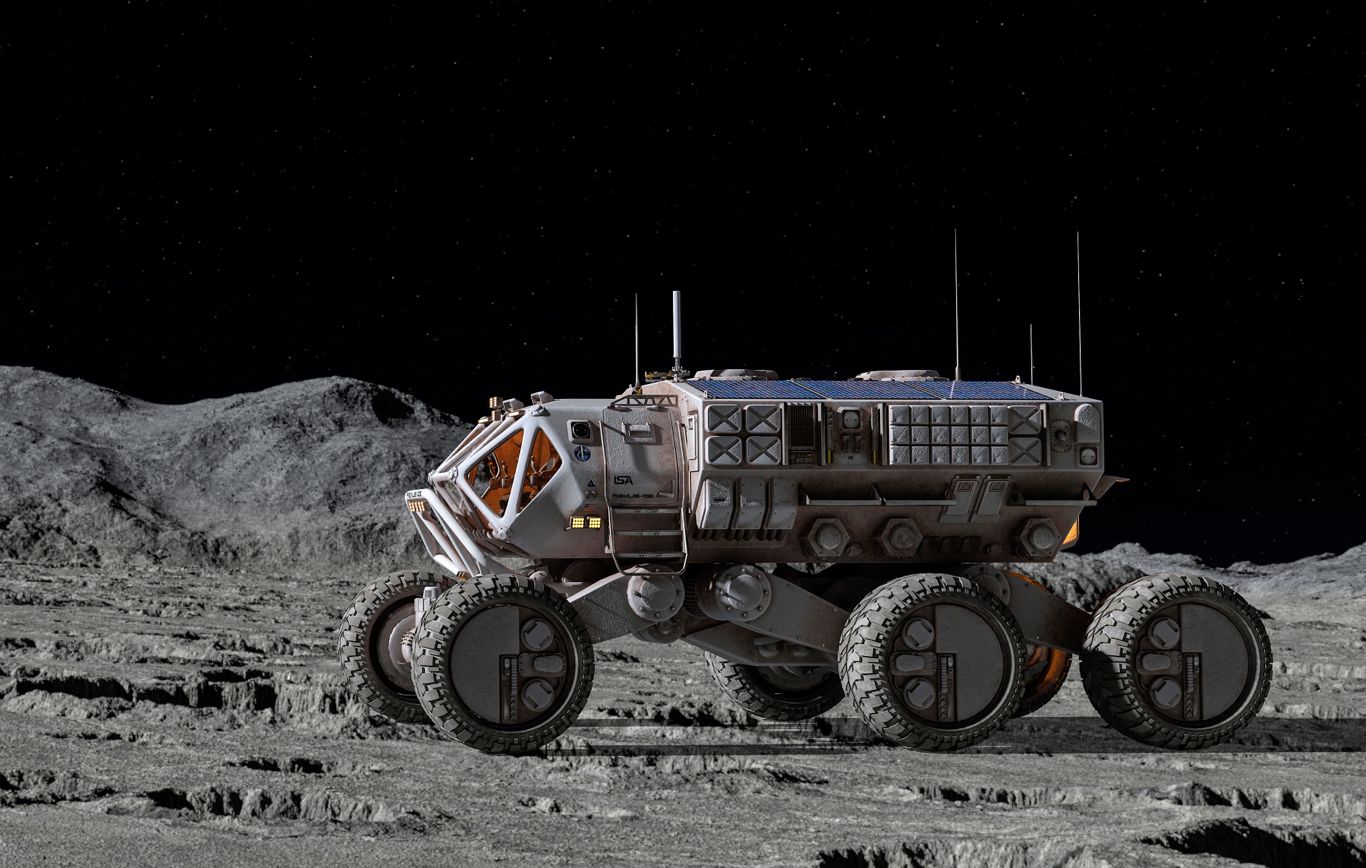
Automotive companies working on lunar rovers (Adobe)
Data storage on the Moon amongst other solutions for the lunar economy
Next month we will witness another attempt to carry out the first ever successful commercial lunar landing, from US-based Intuitive Machines. Onboard the lander will be the first mission being carried out by Lonestar Data Holdings, who will be pioneering data storage on the Moon.
With a rapidly increasing global demand for data storage solutions, off-world storage could offer a number of benefits, including benefiting from the cold environment of space and being able to access limitless solar energy. More importantly, It also provides a safe location for backup and recovery data to be stored, keeping it safe natural disasters or attack; a service dubbed as Data Recovery as a Service (DRaaS).
The company will demonstrate this technology on the Intuitive Machines mission, by transmitting the US Declaration of Independence when on the way to and while in orbit around the Moon, meaning it will become the first digitally stored document on the Moon. In return, they will receive a copy of the US Bill of Rights and Constitution which will be sent from the lunar surface.
The demonstration is to prove Lonestar’s data storage and recovery services and a key component of the new lunar and space economy. Brad Harrison, Scout Ventures' Founder and Managing Partner, one of Lonestar’s funders, said that “We believe that expanding the world's economy to encompass the Moon, Earth's largest satellite, is the next whitespace in the New Space Economy…data security and storage will be a necessary part of leading the new generation of lunar exploration.”
Toyota extend lunar vehicle range, lander companies expand portfolios
Japanese automaker, Toyota, has seemingly taken further steps into the lunar economy this week announcing the concept design for a “Baby Lunar Cruiser”. The vehicle is reportedly designed for managing difficult terrain on Earth, but could also be developed to be used on the Moon, and even withstand the brutal temperature fluctuations of the lunar day and night.
Toyota are also still working with JAXA (Japanese Space Agency) on the design of a larger Lunar Cruiser, expected to be ready by 2029. Hyundai, General Motors and Nissan are some other legacy automakers also currently diversifying and working on lunar vehicle design.
Lunar landing companies Astrobotic (US) and iSpace (Japan) are also diversifying and expanding their portfolios. The former has this week been carrying out more tests of its Xodiac suborbital vehicle, while the company also works on its larger suborbital vehicle, Xogdor, aiming to launch the latter in 2025.
Japan’s iSpace appear to be looking to expand their role in the lunar economy, this week announcing a new joint venture alongside HEX20 (Australia) and Skyroot Aerospace (India) in order to use their shared expertise to provide affordable satellite lunar satellite missions.
This goes to show us just how much scope there is in the development of the lunar economy, beyond only the launch vehicles and landers which will take us there, but also into applications such as data storage, satellite connectivity, satellite observation and lunar mining.
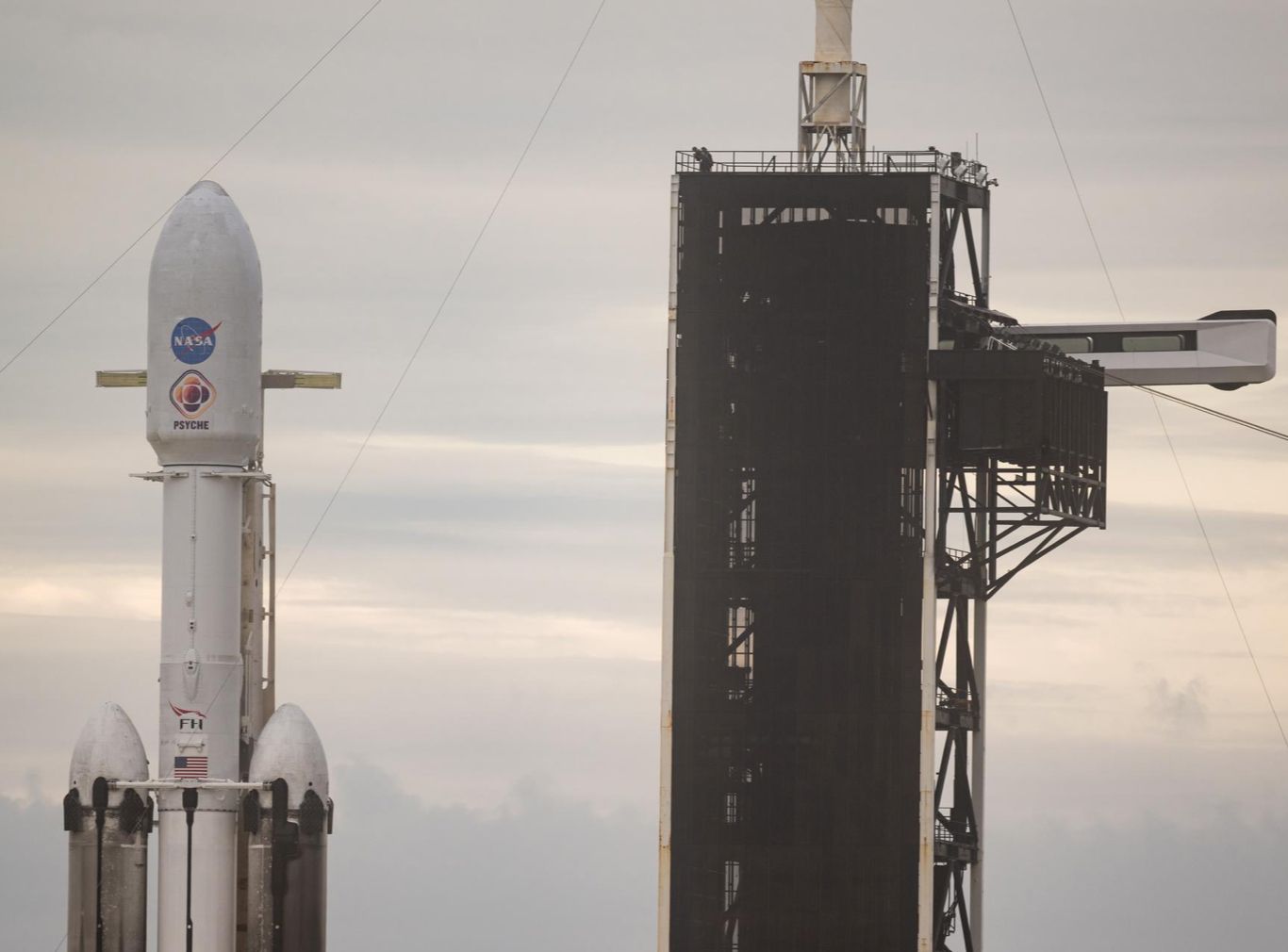
Psyche spacecraft atop a Falcon Heavy (SpaceX)
NASA Psyche launches, China expand lunar alliance and develop remote tech for debris avoidance
On Friday, NASA launched their long-awaited Psyche mission, intended to head to the asteroid of the same name, in order to discover the origins of planets with metallic cores, such Earth’s
The Psyche mission took off atop a SpaceX Falcon Heavy and will take six years to complete the two billion (3.6bn km) mile journey. Most asteroids tend to be made up of rock or ice, but Psyche was discovered to be metallic and so is believed to possibly be the remains of a planetesimal, rocky celestial bodies created during the formation of planets.
Once it arrives, the Psyche probe will remain in orbit around the asteroid, getting as close as 47 miles and remaining there until at least 2031.
China expands alliance and develops debris removal beam
China have continued to build on their International Lunar Research Station (ILRS) plans and have this week gained yet more partners to support their vision of the future for outer space. Azerbaijan have become the latest member after signing a joint statement at the 74th International Astronautical Congress (IAC).
China still trail behind the US-led Artemis Accords (their opposing vision for a regulatory framework for the future of outer space) in terms of numbers of signatories, but now have 15, including South Africa, Venezuela, Asia-Pacific Space Cooperation Organization (APSCO) and the Hawaii-based International Lunar Observatory Association (ILOA).
China may also have taken a step forwards in relation to debris avoidance and satellite servicing, as researchers have announced that have developed technology capable of remotely repelling or attracting objects in space, using magnetic plasma rings. Such technology would could be used to tactically move dangerous objects, such as debris, out of the path of orbiting vehicles, or attract satellites in order to carry out refuelling or servicing, building towards a sustainable space infrastructure.
While the US still seem to be gathering more support under the Artemis Accords, China may still find that they can build leadership in other areas, such as leading the way in remote debris mitigation and sustainability. Furthermore, the space economy is opening up and is no longer about the few, but new players in both the public and private sectors. And there’s much more to come.
Our future in space

ESA Moonlight (Image: ESA-K Oldenburg)
14 October 2023
ESA ask business to stimulate lunar economy, historic Psyche mission launches, data storage on the Moon….and more - Space News Roundup
A report by NASA’s Office of the Inspector General this week highlighted that it will be “unrealistic” for the agency to drastically reduce the spiralling cost of developing the giant SLS rocket used for the Artemis missions, casting doubt on the “…sustainability of NASA’s deep space human exploration efforts,” the report warned.
As we’ve previously mentioned, the Artemis programme could indeed be the last of its kind, of grand, publicly funding space projects. What we are now seeing is role of the private sector expanding, increasing efficiency and the pace of innovation, reducing costs and opening up access to space. With SpaceX’s Starship close to coming online, it’s hard to see if there will be a long-term future for the SLS rocket.
This really is a reflection of the industry as a whole right now, adapting and changing in the face of growing competition as nations realise the massive potential the future of space has to offer. This is moreover being spearheaded by private companies. In the US, NASA have established their Commercial Lunar Payload Services (CLPS) program, designed to purchase lunar landing services from private sector. Intuitive Machines will be the next company aiming to land on the Moon under the CLPS program, launching next month with SpaceX.
In 2020, India established the Indian National Space Promotion and Authorization Center (IN-SPACe), designed to act as a window for private companies entering the space sector. The growing space nation has now witnessed the first flights from private launch companies, and the government has recently carried out a series of reforms aimed at increasing private sector involvement.
The UK is also a rapidly growing space nation, with the bold aim of capturing 10% of the global market by 2030. The country has also now become the second most attractive place for space space venture capital investment, the US being the first.
The list could go on.
Europe calls on the private sector
Europe as a whole has been waking up to the promise of the commercialisation of space. Since 2019 ESA has been encouraging European commercial launch and space transportation services, through their Commercial Space Transportation Services and Support programme, known as” Boost!”, providing expertise and funding to budding European launch startups.
Europe has been grappling with the challenges of maintaining a non-dependent access to space, especially after severing ties with Russia and losing access to their technology. However, Spanish startup, PLD Space, this week took Europe a step closer. The company launched their Miura-1 rocket from the south of Spain carrying a payload for the German Centre for Applied Space Technology and Microgravity, reaching an altitude of 46 km and marking the first private European rocket launch.
European nations and ESA will be hoping this marks the beginning of a foray of debut commercial launches, with companies such as Isar Aerospace (Germany), Rocket Factory Augsburg (Germany), Skyrora (UK) and Orbex Space (UK) all waiting to takeoff for the first time.
ESA are also reaching out to the private sector to help develop infrastructure on the Moon. This week the agency announced a call to businesses to provide services on the Moon that will use their planned “Moonlight” lunar satellite constellation, which will assist in developing the lunar economy. This could include lunar connectivity, surface observation, or perhaps using the satellites to assist mining companies in locating valuable resources, such as water and oxygen.
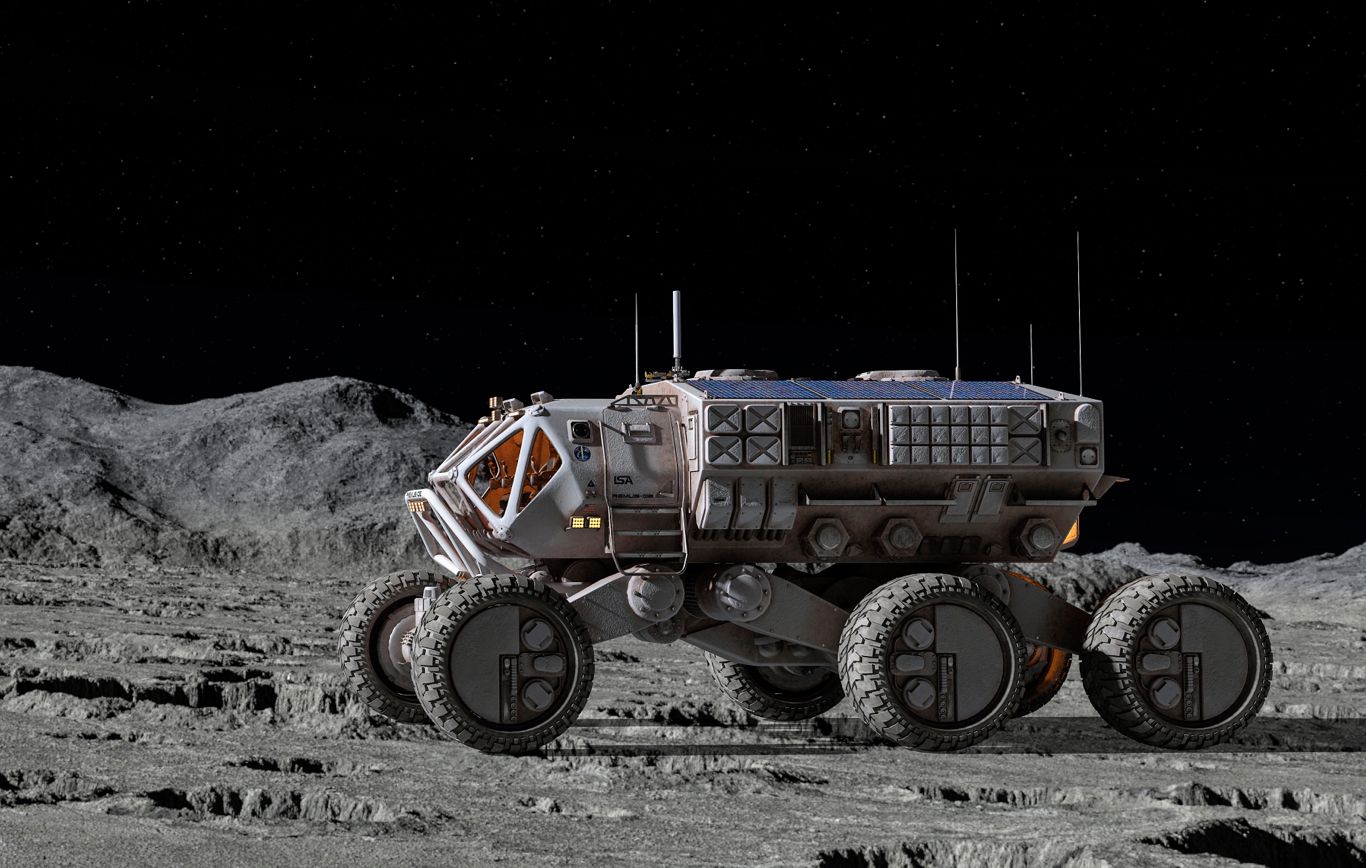
Automotive companies working on lunar rovers (Adobe)
Data storage on the Moon amongst other solutions for the lunar economy
Next month we will witness another attempt to carry out the first ever successful commercial lunar landing, from US-based Intuitive Machines. Onboard the lander will be the first mission being carried out by Lonestar Data Holdings, who will be pioneering data storage on the Moon.
With a rapidly increasing global demand for data storage solutions, off-world storage could offer a number of benefits, including benefiting from the cold environment of space and being able to access limitless solar energy. More importantly, It also provides a safe location for backup and recovery data to be stored, keeping it safe natural disasters or attack; a service dubbed as Data Recovery as a Service (DRaaS).
The company will demonstrate this technology on the Intuitive Machines mission, by transmitting the US Declaration of Independence when on the way to and while in orbit around the Moon, meaning it will become the first digitally stored document on the Moon. In return, they will receive a copy of the US Bill of Rights and Constitution which will be sent from the lunar surface.
The demonstration is to prove Lonestar’s data storage and recovery services and a key component of the new lunar and space economy. Brad Harrison, Scout Ventures' Founder and Managing Partner, one of Lonestar’s funders, said that “We believe that expanding the world's economy to encompass the Moon, Earth's largest satellite, is the next whitespace in the New Space Economy…data security and storage will be a necessary part of leading the new generation of lunar exploration.”
Toyota extend lunar vehicle range, lander companies expand portfolios
Japanese automaker, Toyota, has seemingly taken further steps into the lunar economy this week announcing the concept design for a “Baby Lunar Cruiser”. The vehicle is reportedly designed for managing difficult terrain on Earth, but could also be developed to be used on the Moon, and even withstand the brutal temperature fluctuations of the lunar day and night.
Toyota are also still working with JAXA (Japanese Space Agency) on the design of a larger Lunar Cruiser, expected to be ready by 2029. Hyundai, General Motors and Nissan are some other legacy automakers also currently diversifying and working on lunar vehicle design.
Lunar landing companies Astrobotic (US) and iSpace (Japan) are also diversifying and expanding their portfolios. The former has this week been carrying out more tests of its Xodiac suborbital vehicle, while the company also works on its larger suborbital vehicle, Xogdor, aiming to launch the latter in 2025.
Japan’s iSpace appear to be looking to expand their role in the lunar economy, this week announcing a new joint venture alongside HEX20 (Australia) and Skyroot Aerospace (India) in order to use their shared expertise to provide affordable satellite lunar satellite missions.
This goes to show us just how much scope there is in the development of the lunar economy, beyond only the launch vehicles and landers which will take us there, but also into applications such as data storage, satellite connectivity, satellite observation and lunar mining.
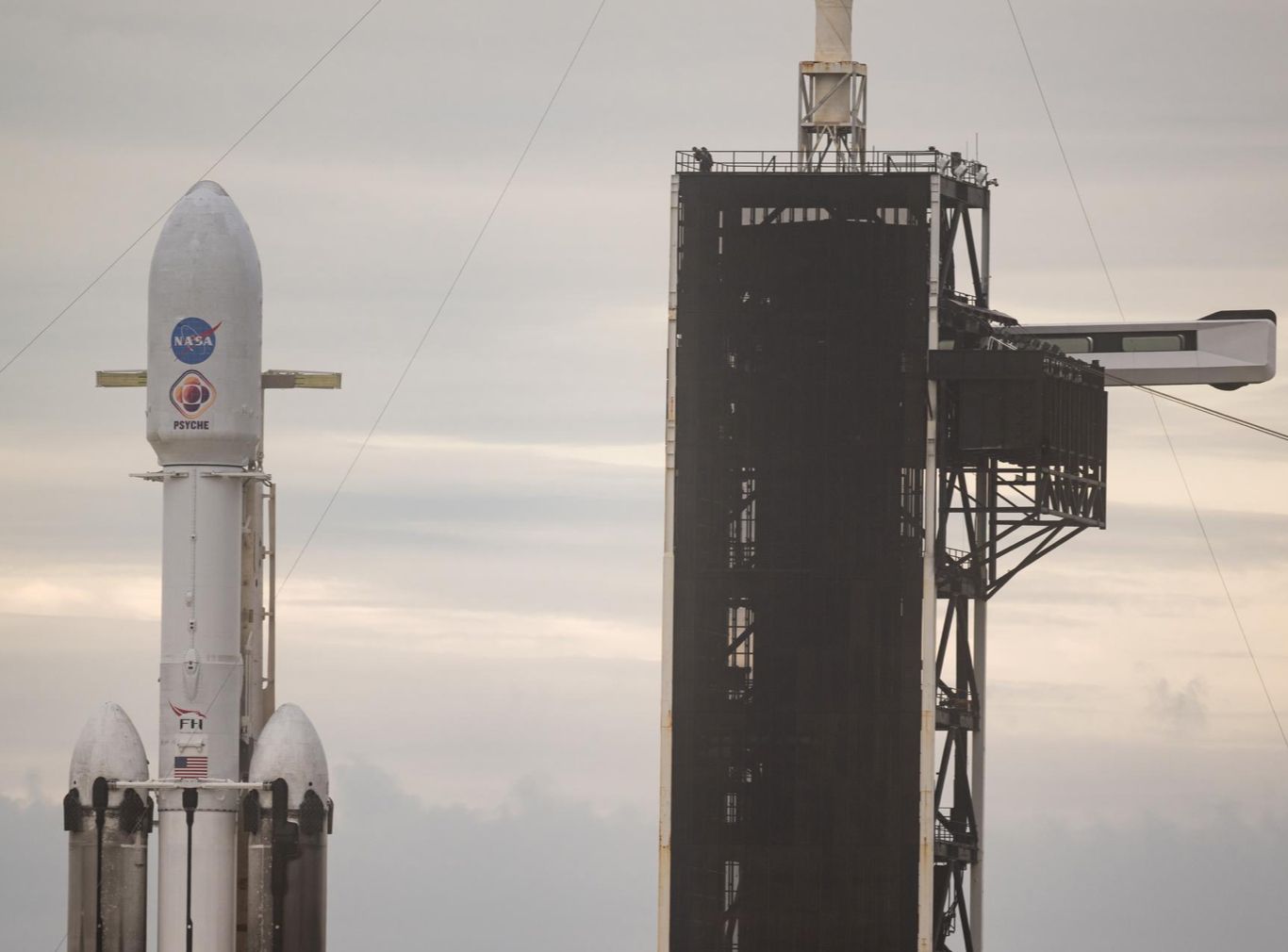
Psyche spacecraft atop a Falcon Heavy (SpaceX)
NASA Psyche launches, China expand lunar alliance and develop remote tech for debris avoidance
On Friday, NASA launched their long-awaited Psyche mission, intended to head to the asteroid of the same name, in order to discover the origins of planets with metallic cores, such Earth’s
The Psyche mission took off atop a SpaceX Falcon Heavy and will take six years to complete the two billion (3.6bn km) mile journey. Most asteroids tend to be made up of rock or ice, but Psyche was discovered to be metallic and so is believed to possibly be the remains of a planetesimal, rocky celestial bodies created during the formation of planets.
Once it arrives, the Psyche probe will remain in orbit around the asteroid, getting as close as 47 miles and remaining there until at least 2031.
China expands alliance and develops debris removal beam
China have continued to build on their International Lunar Research Station (ILRS) plans and have this week gained yet more partners to support their vision of the future for outer space. Azerbaijan have become the latest member after signing a joint statement at the 74th International Astronautical Congress (IAC).
China still trail behind the US-led Artemis Accords (their opposing vision for a regulatory framework for the future of outer space) in terms of numbers of signatories, but now have 15, including South Africa, Venezuela, Asia-Pacific Space Cooperation Organization (APSCO) and the Hawaii-based International Lunar Observatory Association (ILOA).
China may also have taken a step forwards in relation to debris avoidance and satellite servicing, as researchers have announced that have developed technology capable of remotely repelling or attracting objects in space, using magnetic plasma rings. Such technology would could be used to tactically move dangerous objects, such as debris, out of the path of orbiting vehicles, or attract satellites in order to carry out refuelling or servicing, building towards a sustainable space infrastructure.
While the US still seem to be gathering more support under the Artemis Accords, China may still find that they can build leadership in other areas, such as leading the way in remote debris mitigation and sustainability. Furthermore, the space economy is opening up and is no longer about the few, but new players in both the public and private sectors. And there’s much more to come.
Share this article
14 October 2023
ESA ask business to stimulate lunar economy, historic Psyche mission launches, data storage on the Moon….and more - Space News Roundup
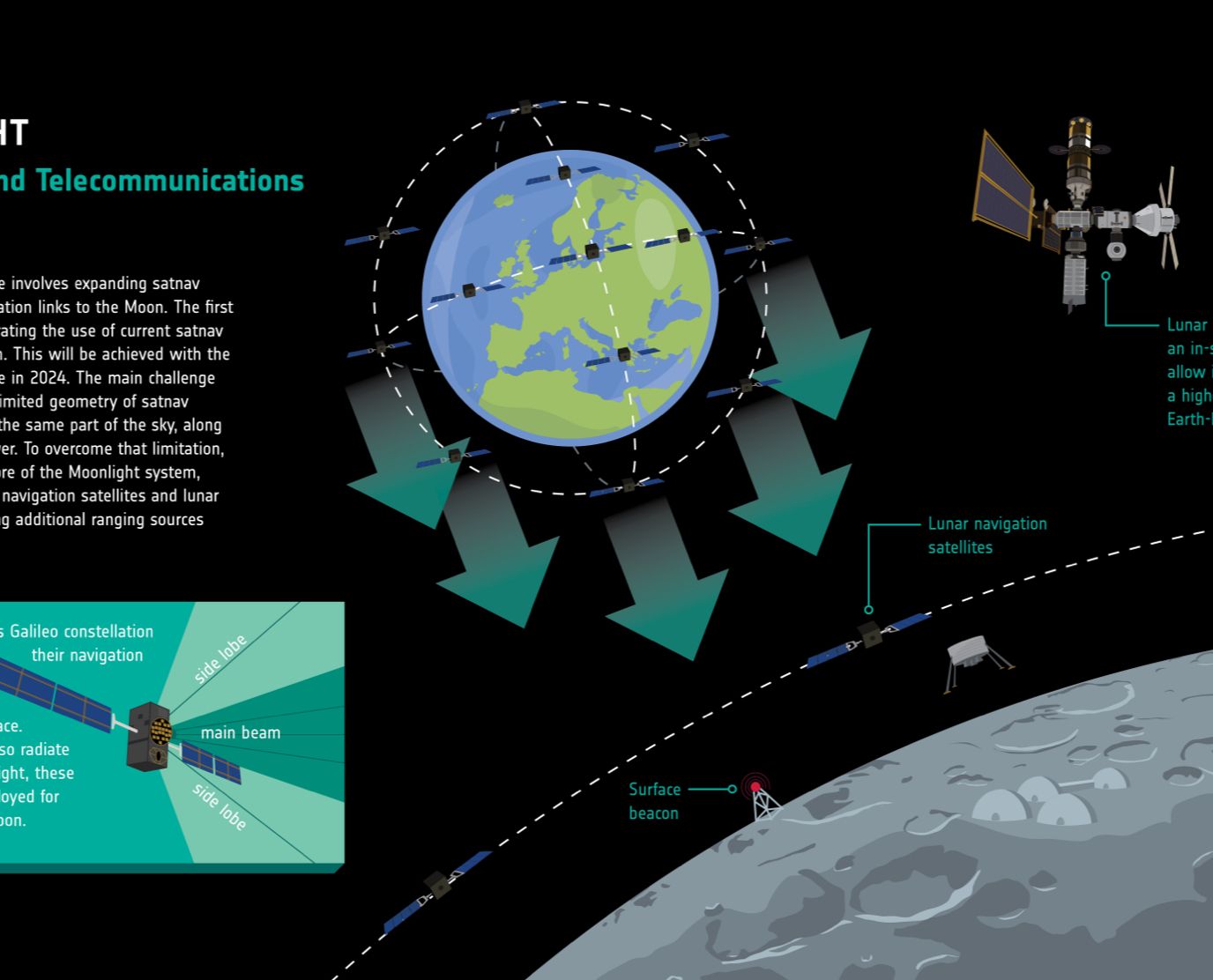
ESA Moonlight (Image: ESA-K Oldenburg)
A report by NASA’s Office of the Inspector General this week highlighted that it will be “unrealistic” for the agency to drastically reduce the spiralling cost of developing the giant SLS rocket used for the Artemis missions, casting doubt on the “…sustainability of NASA’s deep space human exploration efforts,” the report warned.
As we’ve previously mentioned, the Artemis programme could indeed be the last of its kind, of grand, publicly funding space projects. What we are now seeing is role of the private sector expanding, increasing efficiency and the pace of innovation, reducing costs and opening up access to space. With SpaceX’s Starship close to coming online, it’s hard to see if there will be a long-term future for the SLS rocket.
This really is a reflection of the industry as a whole right now, adapting and changing in the face of growing competition as nations realise the massive potential the future of space has to offer. This is moreover being spearheaded by private companies. In the US, NASA have established their Commercial Lunar Payload Services (CLPS) program, designed to purchase lunar landing services from private sector. Intuitive Machines will be the next company aiming to land on the Moon under the CLPS program, launching next month with SpaceX.
In 2020, India established the Indian National Space Promotion and Authorization Center (IN-SPACe), designed to act as a window for private companies entering the space sector. The growing space nation has now witnessed the first flights from private launch companies, and the government has recently carried out a series of reforms aimed at increasing private sector involvement.
The UK is also a rapidly growing space nation, with the bold aim of capturing 10% of the global market by 2030. The country has also now become the second most attractive place for space space venture capital investment, the US being the first.
The list could go on.
Europe calls on the private sector
Europe as a whole has been waking up to the promise of the commercialisation of space. Since 2019 ESA has been encouraging European commercial launch and space transportation services, through their Commercial Space Transportation Services and Support programme, known as” Boost!”, providing expertise and funding to budding European launch startups.
Europe has been grappling with the challenges of maintaining a non-dependent access to space, especially after severing ties with Russia and losing access to their technology. However, Spanish startup, PLD Space, this week took Europe a step closer. The company launched their Miura-1 rocket from the south of Spain carrying a payload for the German Centre for Applied Space Technology and Microgravity, reaching an altitude of 46 km and marking the first private European rocket launch.
European nations and ESA will be hoping this marks the beginning of a foray of debut commercial launches, with companies such as Isar Aerospace (Germany), Rocket Factory Augsburg (Germany), Skyrora (UK) and Orbex Space (UK) all waiting to takeoff for the first time.
ESA are also reaching out to the private sector to help develop infrastructure on the Moon. This week the agency announced a call to businesses to provide services on the Moon that will use their planned “Moonlight” lunar satellite constellation, which will assist in developing the lunar economy. This could include lunar connectivity, surface observation, or perhaps using the satellites to assist mining companies in locating valuable resources, such as water and oxygen.
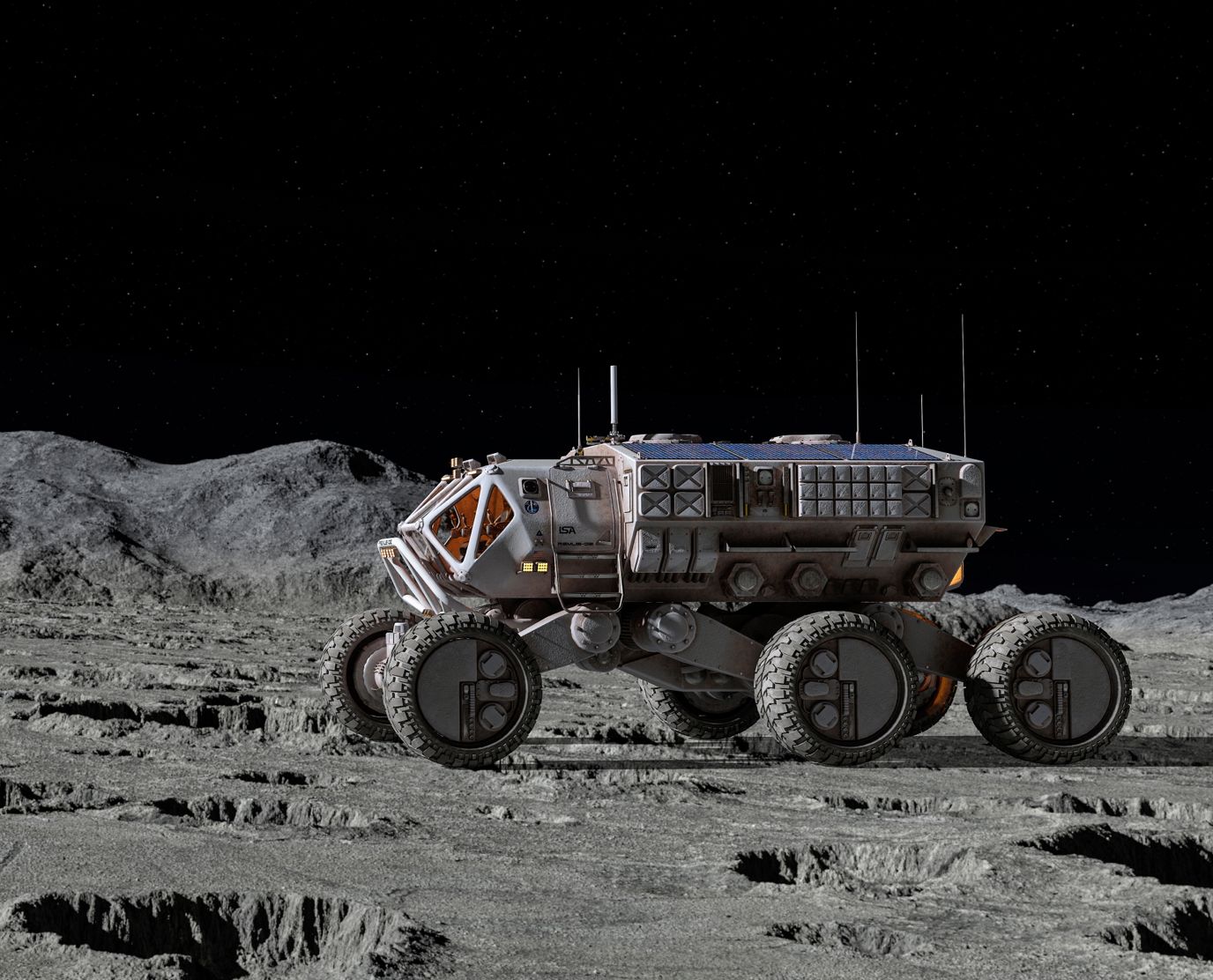
Automotive companies working on lunar rovers (Adobe)
Data storage on the Moon amongst other solutions for the lunar economy
Next month we will witness another attempt to carry out the first ever successful commercial lunar landing, from US-based Intuitive Machines. Onboard the lander will be the first mission being carried out by Lonestar Data Holdings, who will be pioneering data storage on the Moon.
With a rapidly increasing global demand for data storage solutions, off-world storage could offer a number of benefits, including benefiting from the cold environment of space and being able to access limitless solar energy. More importantly, It also provides a safe location for backup and recovery data to be stored, keeping it safe natural disasters or attack; a service dubbed as Data Recovery as a Service (DRaaS).
The company will demonstrate this technology on the Intuitive Machines mission, by transmitting the US Declaration of Independence when on the way to and while in orbit around the Moon, meaning it will become the first digitally stored document on the Moon. In return, they will receive a copy of the US Bill of Rights and Constitution which will be sent from the lunar surface.
The demonstration is to prove Lonestar’s data storage and recovery services and a key component of the new lunar and space economy. Brad Harrison, Scout Ventures' Founder and Managing Partner, one of Lonestar’s funders, said that “We believe that expanding the world's economy to encompass the Moon, Earth's largest satellite, is the next whitespace in the New Space Economy…data security and storage will be a necessary part of leading the new generation of lunar exploration.”
Toyota extend lunar vehicle range, lander companies expand portfolios
Japanese automaker, Toyota, has seemingly taken further steps into the lunar economy this week announcing the concept design for a “Baby Lunar Cruiser”. The vehicle is reportedly designed for managing difficult terrain on Earth, but could also be developed to be used on the Moon, and even withstand the brutal temperature fluctuations of the lunar day and night.
Toyota are also still working with JAXA (Japanese Space Agency) on the design of a larger Lunar Cruiser, expected to be ready by 2029. Hyundai, General Motors and Nissan are some other legacy automakers also currently diversifying and working on lunar vehicle design.
Lunar landing companies Astrobotic (US) and iSpace (Japan) are also diversifying and expanding their portfolios. The former has this week been carrying out more tests of its Xodiac suborbital vehicle, while the company also works on its larger suborbital vehicle, Xogdor, aiming to launch the latter in 2025.
Japan’s iSpace appear to be looking to expand their role in the lunar economy, this week announcing a new joint venture alongside HEX20 (Australia) and Skyroot Aerospace (India) in order to use their shared expertise to provide affordable satellite lunar satellite missions.
This goes to show us just how much scope there is in the development of the lunar economy, beyond only the launch vehicles and landers which will take us there, but also into applications such as data storage, satellite connectivity, satellite observation and lunar mining.
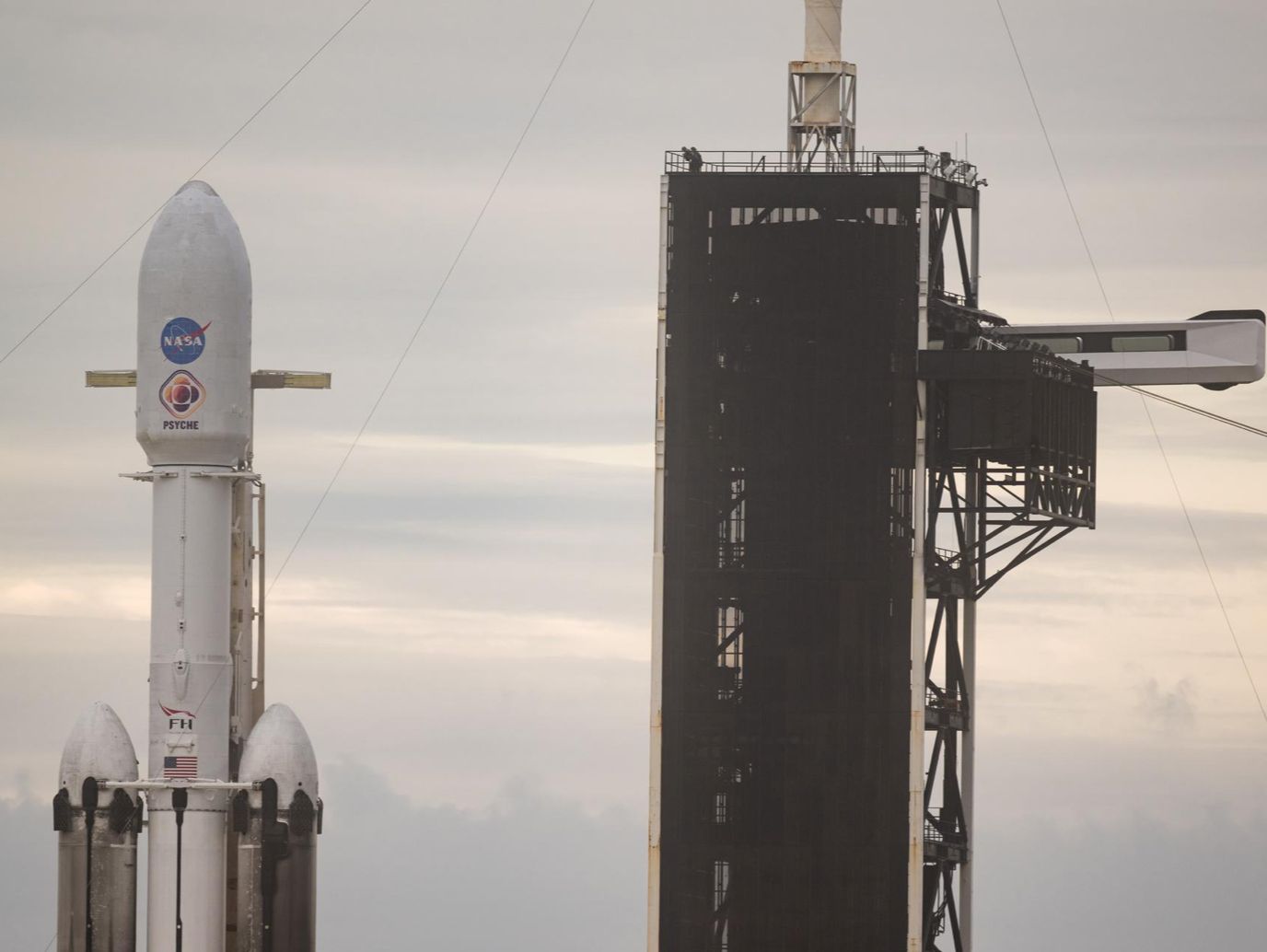
Psyche spacecraft atop a Falcon Heavy (SpaceX)
NASA Psyche launches, China expand lunar alliance and develop remote tech for debris avoidance
On Friday, NASA launched their long-awaited Psyche mission, intended to head to the asteroid of the same name, in order to discover the origins of planets with metallic cores, such Earth’s
The Psyche mission took off atop a SpaceX Falcon Heavy and will take six years to complete the two billion (3.6bn km) mile journey. Most asteroids tend to be made up of rock or ice, but Psyche was discovered to be metallic and so is believed to possibly be the remains of a planetesimal, rocky celestial bodies created during the formation of planets.
Once it arrives, the Psyche probe will remain in orbit around the asteroid, getting as close as 47 miles and remaining there until at least 2031.
China expands alliance and develops debris removal beam
China have continued to build on their International Lunar Research Station (ILRS) plans and have this week gained yet more partners to support their vision of the future for outer space. Azerbaijan have become the latest member after signing a joint statement at the 74th International Astronautical Congress (IAC).
China still trail behind the US-led Artemis Accords (their opposing vision for a regulatory framework for the future of outer space) in terms of numbers of signatories, but now have 15, including South Africa, Venezuela, Asia-Pacific Space Cooperation Organization (APSCO) and the Hawaii-based International Lunar Observatory Association (ILOA).
China may also have taken a step forwards in relation to debris avoidance and satellite servicing, as researchers have announced that have developed technology capable of remotely repelling or attracting objects in space, using magnetic plasma rings. Such technology would could be used to tactically move dangerous objects, such as debris, out of the path of orbiting vehicles, or attract satellites in order to carry out refuelling or servicing, building towards a sustainable space infrastructure.
While the US still seem to be gathering more support under the Artemis Accords, China may still find that they can build leadership in other areas, such as leading the way in remote debris mitigation and sustainability. Furthermore, the space economy is opening up and is no longer about the few, but new players in both the public and private sectors. And there’s much more to come.
Share this article

